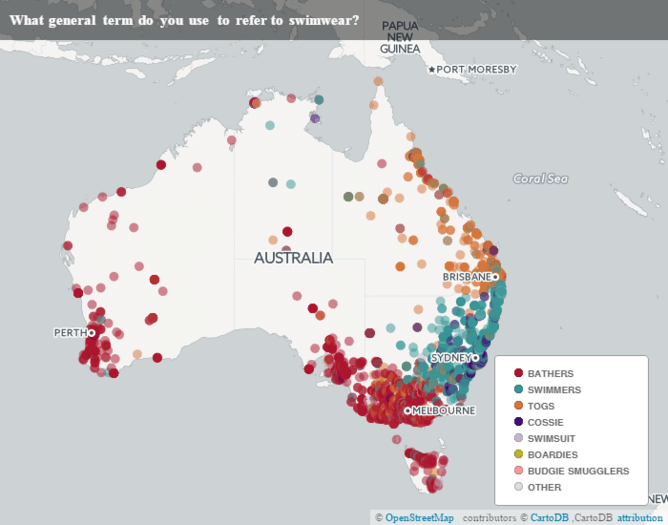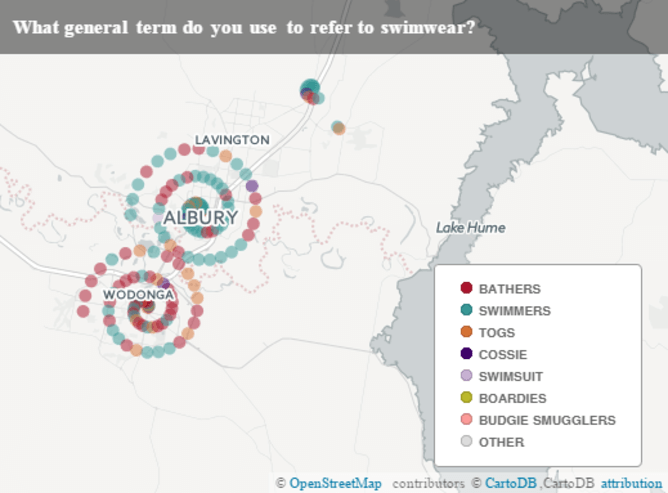Togs or swimmers? Why Australians use different words to describe the same things

Is Australia about to descend into civil war over whether a deep-fried potato snack is rightfully called a “potato cake” or a “potato scallop”? From some recent headlines, you might be forgiven for thinking so.
A series of maps showing differences in words used across Australia sparked fierce debates online over the virtues of calling a barbecued sausage served in a single slice of bread a “sausage in bread” or a “sausage sandwich”.
Given that these maps were put together as part of an educational activity for students participating in the Linguistics Roadshow, the huge interest in the way Australian English is used across the country took us by surprise. But, perhaps it shouldn’t have.
It’s often said that Australian English doesn’t vary much geographically – and it’s true that we don’t find the same striking linguistic differences across the country as in some other corners of the English-speaking world.
However, past and ongoing research has shown that there are some regional differences. Among the most obvious are the words people use for the same thing, such as swimwear – preferences for “togs”, “swimmers”, “cossie” or “bathers” vary markedly across the states and territories.

Where do these linguistic differences stem from?
Australian English developed from the speech of colonists from various parts of the British Isles, so sometimes the word used in a particular Australian region is the result of one option winning out among people from different British backgrounds.
Others might be derived from the names of people or brands, or borrowed from local Indigenous languages.
Each word has its own history, but many words across the country have a shared history - that’s what makes these exceptions stand out.
What’s fascinating is just how neatly some of this variation lines up with state lines, which suggests that there is something more than just the historical choices made by colonists or the distance between different locations contributing to these differences.
Striking examples of this phenomenon can be seen for border towns such as Albury-Wodonga, where a short walk across the bridge means you’ll hear a majority of people using a different word for swimwear.

This is because certain words become strongly associated with a regional identity.
When there is more than one option to choose from, individuals might use a particular word because it’s the most common term in their community, but also because that word indexes a broader group identity, such as Victorian versus New South Wales.
Words are particularly good at doing this kind of work: they very easily become identity markers that people orient to.
Pronunciation differences can also function in this way: does “dance” rhyme with “aunts” or “pants” for you?
Other kinds of variation can fly under the radar because they’re more subtle, or part of a change in progress.
Many Australians are not aware, for example, that in parts of Victoria “celery” is pronounced more like “salary” – listen out for it next time you’re in “Malbourne”!
When we communicate we tend to use the words, pronunciations and linguistic patterns that we hear most often in the communities we live in.
Identity is a dynamic and ongoing process that we all actively participate in, and we use the variation inherent in language to express who we are at any given moment.
What is Australian English?
Australian English is really a broad cover term for different types of English used across the country, including the varieties used by different Indigenous and ethnocultural groups.
This is cross-cut by the linguistic preferences of people representing different age groups, gender identities, and social and cultural backgrounds, with different vocations, interests and networks.
We are part of many communities simultaneously and can express our belonging in varied ways.
Someone can be an Australian, a Thai descendent, a soccer player, a woman, a student of medicine, and a Tumblr user, and be very adept at gauging the different spaces they participate in and choosing how they want to identify within them.
This is an important part of what languages do – they allow us to communicate not just information, but something about who we are.

So, next time you find yourself arguing about sausage sandwiches versus sausages in bread, remember that whichever term you use, you’re contributing to the dynamic linguistic diversity of Australia.
Jill Vaughan, Research Fellow in Linguistics, University of Melbourne; Katie Jepson, PhD student, ARC Centre of Excellence for the Dynamics of Language, Research Unit for Indigenous Language, School of Languages and Linguistics, University of Melbourne, and Rosey Billington, Affiliate, ARC Centre of Excellence for the Dynamics of Language, Postgraduate researcher, School of Languages and Linguistics, University of Melbourne
This article was originally published on The Conversation. Read the original article.





















